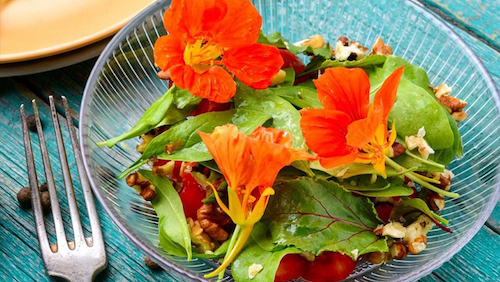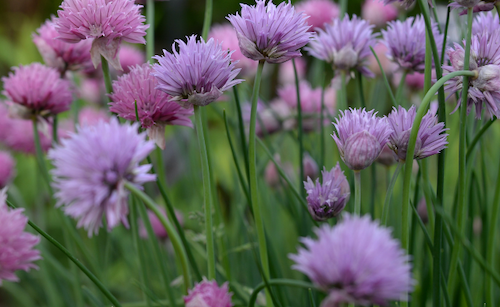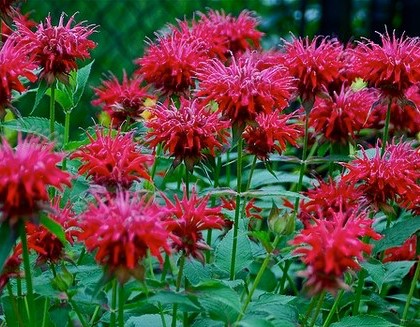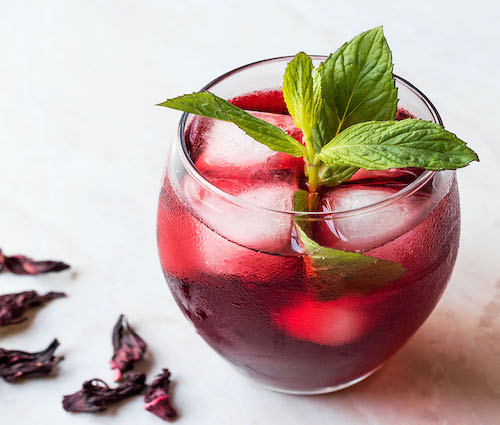Edible Flowers – More Than a Garnish
By Janet Scheren, Fairfax Master Gardener

Nasturtium flowers in salad
To attract pollinators and beneficial insects and create a healthy ecosystem, it’s generally recommended to plant 40 percent of your vegetable garden in flowers. So, why not get twice the benefit from your blossoms by incorporating edible flowers? Surprisingly, so many of the beautiful blooms we enjoy in our gardens are edible, and many are highly nutritious. As a bonus, you’ll have plenty of blossoms for salads, cocktails, ice cream, desserts, fruit compotes, stuffed squash blossoms and so much more.
Nutrition and Other Reasons to Include Blossoms
You may be surprised to know that many flowers, such as squash blossoms, are the most nutritious part of a plant. One report on the National Institutes of Health website mentions flowers as the new vegetable. Others talk about the bright colors of petals providing a high concentration of the antioxidants, anthocyanins, flavonoids, carotenoids, minerals and other nutritious substances we value in highly colored fruits and vegetables.
For the home gardener, this is just one of the many reasons to include blossoms in your recipes. It’s also a way to eliminate waste. For example, you often wind up with more male squash blossoms than female. The female blossoms go on to bear fruit, but the male blossoms fade and go to waste. So, clever gardeners in many cultures from Italy to Mexico have learned to stuff squash blossoms with cheese or other fillings and sauté or fry them. Yum!
The bottom line is that eating blossoms is a great way to get maximum benefit from your garden, take your culinary skills to new heights and reduce waste.

Chive flowers
Matching Taste and Color to Food
While a rose by any other name would smell as sweet, not all blossoms taste as sweet as they look. There’s a reason why violets rather than chive blossoms top fancy cupcakes. A chive blossom tastes of onion, while violets are sweet and aromatic. Chive blossom cream cheese for your bagel, anyone?
Sweet or floral scented blossoms can be used to decorate desserts or garnish cold drinks. Peppery nasturtiums, cucumber-flavored borage and onion-flavored chive blossoms add interest to salads. Daylily petals and squash blossoms can also adorn salads and other savory foods.
Here’s a list of some common edible blossoms with flavor notes or uses:
- Alpine Strawberry (Fragaria vesca) — strawberry flavor
- Anise Hyssop (Agastache foeniculum) — licorice flavor
- Chamomile, German (Matricaria chamomilla) — apple scent and flavor, often used in tea
- Apple or Plum (Malus) — mild, sweet floral flavor
- Beebalm (Monarda didyma) — citrusy, sweet, hot, minty flavor depending on cultivar

Monarda didyma
- Basil (Ocimum spp.) — taste varies by cultivar but tastes a lot like its leaves; pair with pineapple for refreshing sorbet or cocktails
- Borage (Borago officinalis) — cucumber flavor (diuretic in large quantities), use in salads or cocktails, like gin and tonic
- Calendula (Calendula officinalis) — often referred to as “poor man’s saffron,” tastes like saffron when sautéed in olive oil to release its flavor
- Chive (Allium schoenoprasum) — onion flavor
- Coriander (Coriandrum sativum) — anise, cumin, orange, and sage
- Daikon Radish (Raphanus sativus) — same peppery bite as the root, but far milder with a honeyed finish, great for salads
- Dandelion (Taraxacum officinale) — honeylike flavor when picked young
- Daylily (Hemerocallis spp.) — varies by cultivar, generally a mild flavor. Note: Don’t eat flowers of other types of lily.
- Dill (Anethum) — used in pickling, dips, sauces, fish dishes
- Fennel (Foeniculum vulgare) — mild anise, licorice flavor
- Greek oregano (Origanum vulgare hirtum) — spicy oregano flavor
- Hibiscus (Hibiscus rosa-sinensis) — mild citrus flavor, adds red color to teas

Hibiscus tea with mint
- Hyssop (Hyssopus officinalis) — tastes similar to tonic water
- Lavender (Lavandula angustifolia) — fragrant but can become bitter, used in ice cream, baked goods, herbes de provence, teas or lemonade
- Lemon Balm (Melissa officinalis) — mildly lemon-scented
- Lemon Verbena (Aleysia citrodora) — used dried for tea, flavoring lemon syrup
- Lilac (Syringa vulgaris) — depending on cultivar, from no flavor to a green flavor to a true floral lilac flavor; use flowers in ice cream, soft cheeses, pastries
- Mint (Mentha spp.) — minty flavor; often used in fruit salad, cocktails, sauces, chutneys
- Nasturtium (Tropaeolum majus) — mild/sweet with a peppery bite; use fresh in salads
- Oregano (Origanum vulgare) — light minty flavor with thyme overtones
- Pansy (Viola tricolor) — grassy, green flavor great for summer cocktails, fruit salads and garnish for hors d’oeuvres.
- Pineapple Sage (Salvia elegans) — sweet with fruity, mint flavor and a little spiciness
- Rose (Rosa rugosa) — quite subtle and fruity, use petals for tea, vinaigrette, desserts, and garnish
- Rosemary (Salvia rosmarinus) — milder than leaves; sprinkle on salads, pasta, poultry-based soups.
- Sage (Salvia officinalis) — sweet-savory flavor great to sprinkle on pasta, salads, poultry; pair with lemon for a refreshing treat

Squash blossom
- Scented geraniums (Pelargonium spp.) — flavors depend on variety (rose, orange, mint, etc.); flowers and leaves used to flavor jellies, sugar, butter, cakes, tea, honey
- Squash (Curcurbita spp.) — remove stamens and pistils, stuff flowers and fry, can be used fresh on salads as well
- Violet (Viola) — sweet and aromatic, great for almost any culinary use from salads to cupcakes
How to Harvest and Prep
It’s best to harvest blossoms during the cool portion of the day, typically when blossoms are newly opened. Clean blossoms by gently washing in a large bowl of cold water and allowing to air dry on a paper towel. Use immediately or refrigerate in an airtight container lined with a damp paper towel for up to a week.
Safety First
Just as not all flowers are edible, not all parts of edible flowers are safe to eat. Often only a particular part of the flower is edible. So, unless you know otherwise, remove stamens and pistils from edible flowers and eat only the petals. Additionally, choose only edible flowers that have not been treated with pesticides. Assume that any flower you purchase has been treated with pesticides or other unsafe chemicals unless it’s specifically sold as edible. For home grown blossoms, be sure to avoid use of pesticides or herbicides of any kind on or around flowers you intend to eat. Keep in mind that chemicals sprayed anywhere in your garden will have a certain amount of drift. A final caveat is the unlikely potential for a food allergy. So, like all other novel foods, it’s a good idea to try a small quantity to start.
To play it safe, consult a reliable reference for edible flowers, such as the AMA Handbook of Poisonous and Injurious Plants published by the American Medical Association before trusting that flowers included in a recipe are safe to consume.
Also keep in mind that any garnish you use should be edible. That applies to flowers as well as other parts of plants — even on the edge of a platter. With the increased use of blossoms in food, guests might assume the flowers, leaves or stems used are edible with serious consequences.
Resources
• The Biodiversity of Edible Flowers: Discovering New Tastes and New Health Benefits, S. Benvenuti
and M. Mazzoncini, Front Plant Science, 2021 Feb 22, National Center for Biotechnology Information,
National Library of Medicine
• Edible flowers — a new promising source of mineral elements in human nutrition, Otakar Rop, Jiri
Mlcek, Tunde Jurikova, Jarmila Neugebauerova, Jindriska Vabkova, National Center for
Biotechnology Information, National Library of Medicine
• Edible Flowers: From Garden to Palate, by Cathy Wilkinson Barash
• Edible Landscaping, by Rosalind Creasy
• The Edible Flower Garden, by Rosalind Creasy
• AMA Handbook of Poisonous and Injurious Plants, Dr. Kenneth F. Lampe and Mary Ann McCann,
Division of Drugs and Technology, American Medical Association
• Edible Flowers, Julie Weisenhorn and Ginny Coyle, University of Minnesota Extension